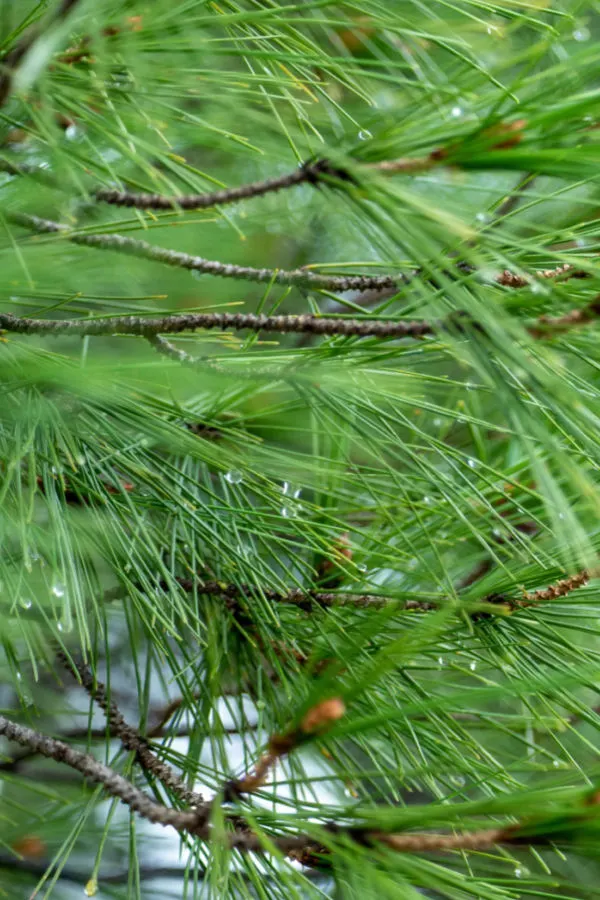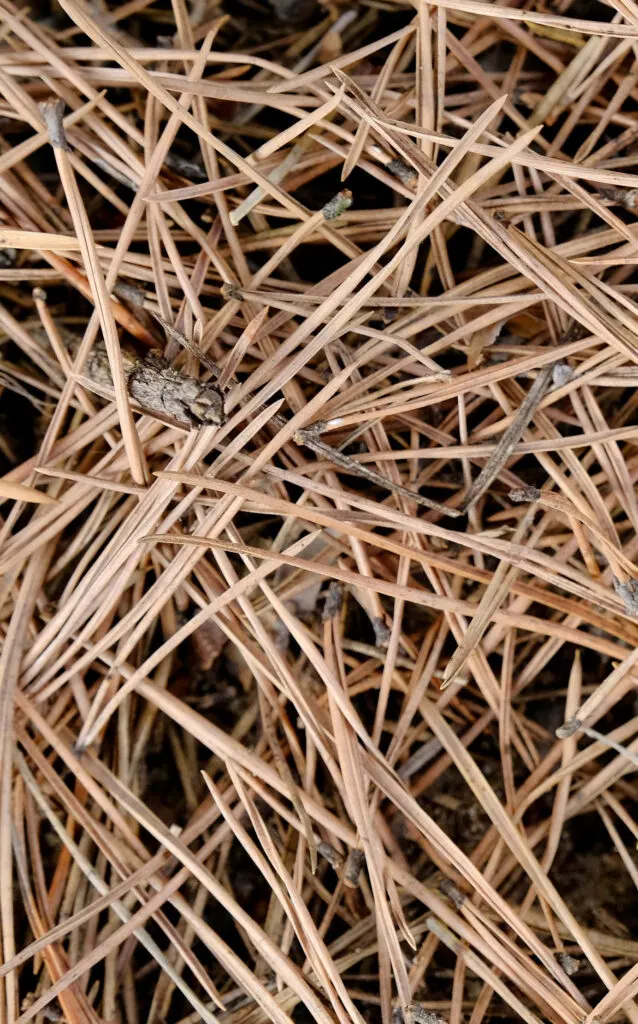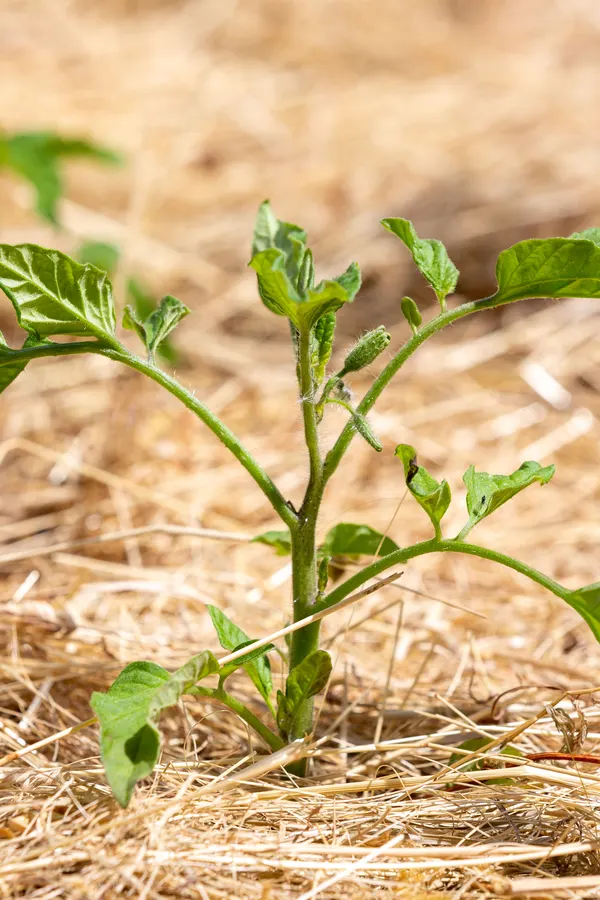Can I use pine needles to mulch my garden and flowerbeds? Should I put them in my compost pile? Are pine needles safe to use around my vegetable plants? What about using them to protect perennials over the winter?
When it comes to pine needles and how and where to use them in the landscape, there are often way more questions than solid answers. And it’s easy to see why. There are a lot of misconceptions and misinformation when it comes to pine needles, and it certainly leads to a lot of confusion about just how valuable they are to a gardener, and where they can safely and effectively use them.
The simple truth is, pine needles can be wonderful for a whole slew of uses when it comes to gardening. Both in the vegetable garden and in flowerbeds as well. But the key to success is knowing when, where and how to use them – and more importantly, where not to!

Hopefully, today’s article will shed some light on the subject, and in the process, dispel some of the myths that exist about how good or bad pine needles can be for your soil and plants. With that in mind, let’s start by taking a look at one of the biggest areas of confusion when it comes to pine needles, their acidity!
How To Use Pine Needles In Gardens & Flowerbeds
Are Pine Needles Acidic?
To be honest, pine needles get a bit of a bad reputation when it comes to being overly acidic. Many gardeners mistakenly think you can only use needles around acid-loving plants, but as you will see below, that is not always the case.
When needles are on a tree and green, they are acidic in nature. In fact, most pine needles will register around 3.0 to 3.5 on the PH scale while green.
But as pine needles age and break down, much of that acidity is lost. In fact, by the time needles die and drop to the ground, although they still are slightly acidic, they are much closer to a neutral PH. And after they age a bit even more and turn brown, they basically register as neutral.

Once pine needles have decomposed completely, either by naturally breaking down or via composting (more on composting pine needles later), they are completely neutral in PH. Because of that, once they are, you can use them near almost any vegetable or flower plant without worry.
Dispelling The Myth – How To Use Pine Needles In Gardens & Flowerbeds
That is actually a very important fact, because it means once needles break down in the soil, they simply do not cause the soil to become more acidic. Unfortunately, the myth that needles cause the soil to become acidic leads to a lot of confusion as to where you can and can’t use them.
Now that we have covered the topic of acidity, let’s take a close look at how and where pine needles can best be used in their various states of decomposition. And, even though they may not be acidic, also why and where they shouldn’t be used in some situations.
Pine Needles As A Mulch – How To Use Pine Needles In Gardens & Flowerbeds
The sheer volume and availability of pine needles makes them excellent for use as a mulch. One thing is for sure, pine needles can be found in abundance in a wide range of climates.
Varieties of pine trees can be found growing from areas that see bitter winter cold to locations where the the temperature rarely drops below 50°. Add in that needles, much like leaves, fall from trees every year, and it’s easy to see how they can be a great source as a natural, easily available and inexpensive mulch.

But where do they work best as a mulch? Brown (aged) needles are great for mulching flowerbeds and around bushes or trees. Again, remember that they are near neutral in PH and will not affect the plants or the soil when it comes to acidity.
A three to four inch layer of fallen pine needles can do wonders to keep weed seeds out and flowerbeds looking fresh. The needles also break down very slowly, saving on the amount of re-mulching that will need to take place. Especially in perennial flowerbeds that are not worked as often.
For perennials and bushes that love more acidic soil, you can mulch with fresher needles. Azaleas, rhododendrons, blueberry bushes and even strawberry plants prefer slightly acidic soil. To help these plants, mulch around them with green needles or freshly fallen pine needles.
The green needles will provide the most acidity for plants, but even freshly fallen needles will give a small dose of acid to plants as it leaches out, helping them in the process.
Pine Needles In The Vegetable Garden – How To Use Pine Needles In Gardens & Flowerbeds
Whether or not to use pine needles in the garden is often a confusing subject for gardeners. The good news is that you can use brown needles anywhere in a garden without worry of acidity. But they are better to use as a mulch for walking rows than around vegetable plants.
A thick layer of pine needles is an excellent way to mulch between your rows. They help to keep weeds out, and allow you to walk the rows freely without worry. Unfortunately, they are not as good right around the plants, but interestingly enough, it has nothing to do with acidity as is often thought.

Pine needles are thin and narrow. Because of that, they are poor insulators of the soil and do not hold in moisture well either. They also often mat together over time, and can keep water and nutrients from getting to the roots if too thick.
In addition, because they take so long to break down, they do not add an abundance of organic material to the soil very quickly. Straw, grass clippings, and compost all do much better at adding nutrients. Even more, they are also better at insulating and holding in moisture.
Another Great Use For Pine Needles In The Garden
For these very reasons, those three are the best choice for mulching right around vegetable plants. Pine needles, however, do have another use in the garden besides walking row mulch that can be quite helpful.
Pine needles are excellent for putting out around the edges of sprawling, vining crops. This can easily help to keep fruit off of the bare ground and out of danger of rotting. This is because the needles dry quicker than straw or grass clippings and still provide good air flow.
Cucumbers, melons, pumpkins, zucchini and squash are all great candidates for this! Simply lay a few inches of needles on the ground and let the vines grow on top.

Composting Pine Needles – How To Use Pine Needles In Gardens & Flowerbeds
Finally, there is the topic of composting pine needles. Or more to the point, should you use them in a home compost pile. The short answer is that it is best to leave them out of a home compost pile. Again, it is not due to any acidity issues at all. Once fully composted, pine needles are not acidic at all.
The reason you should not use pine needles is that they are extremely slow in decomposing. Pine needles have a waxy outer coating that is slow to break down. Because of that, it can take tremendously longer to create fresh compost. Even when you chop them up. See: The Secrets To Making Great Compost
When it comes to pine needles, you are better off to create a dedicated pile of needles. They will break down slowly, but you can then have them at the ready to use anywhere and everywhere you need them.
Here is to using pine needles in your landscape in the best way possible. And even more, to healthier and happier plants as well!
Follow Our Facebook Page For Great Gardening Tips And Advice! This Is My Garden Facebook Page
This Is My Garden is a garden website created by gardeners, for gardeners. Jim and Mary Competti have been writing gardening, DIY and recipe articles and books and speaking for over 15 years from their 46 acre Ohio farm. They publish three articles every week, 52 weeks a year. Sign up today to follow via email, or follow along!

